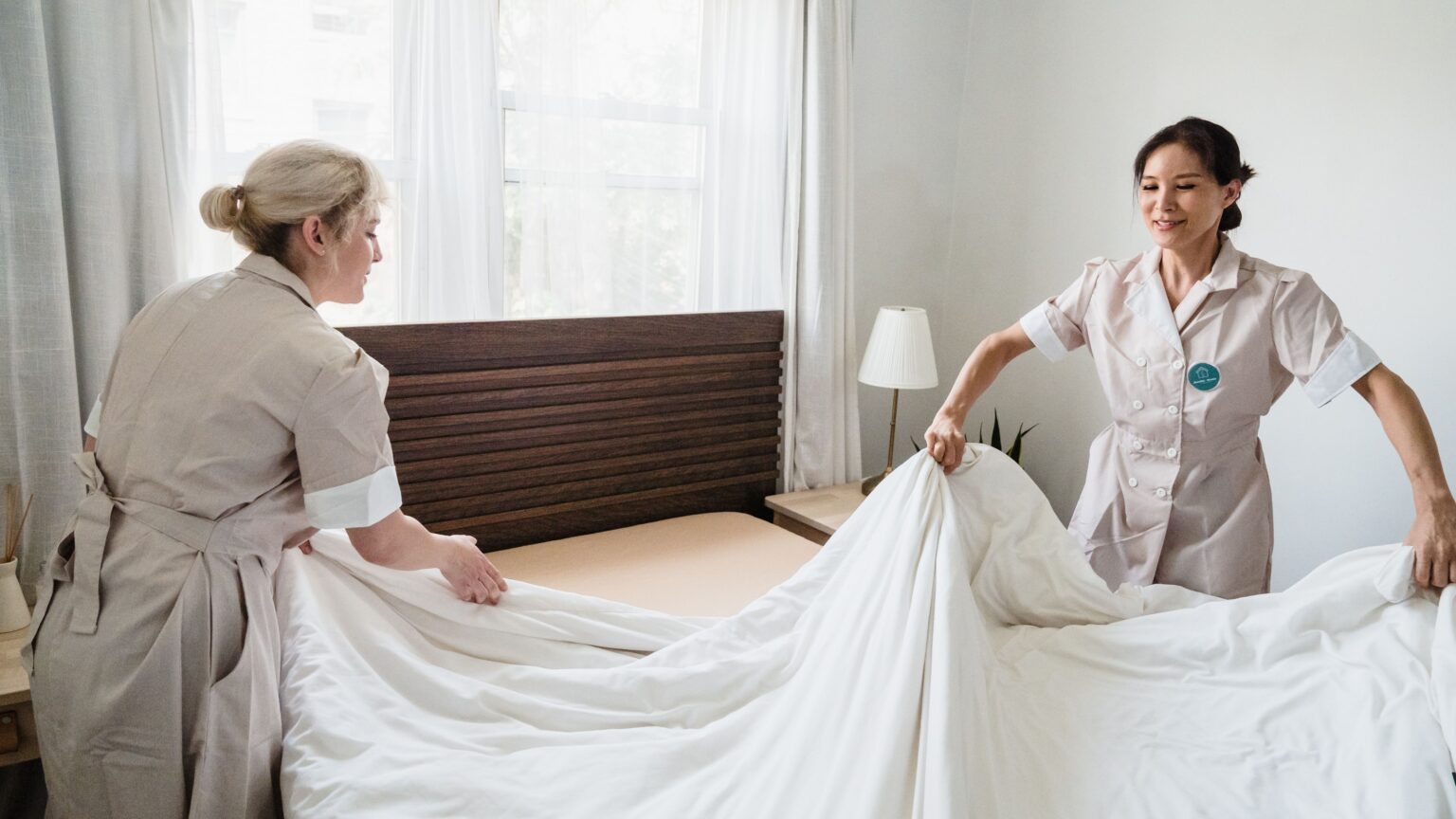After 12 years working in hotel housekeeping departments across different price points—from budget motels to five-star resorts—I’m going to share the secrets that hotel management would prefer guests never learn. This isn’t about bashing hardworking housekeeping staff or discouraging hotel stays. It’s about pulling back the curtain on an industry where profits, time pressures, and unrealistic expectations create a system that prioritizes the appearance of cleanliness over actual sanitation.
The women and men who clean your hotel rooms work incredibly hard under challenging conditions, but they’re operating within constraints that most guests don’t understand. When you know the realities behind hotel room cleaning, you can make informed decisions to protect your health and comfort while still enjoying the convenience of hotel travel.
Some of what you’re about to learn might surprise you. Other revelations might confirm suspicions you’ve had after noticing inconsistencies in room cleanliness. Either way, this insider knowledge will change how you approach hotel stays and help you travel more safely and confidently.
The Time Crunch Reality: Why Corners Get Cut
The single biggest factor affecting hotel room cleanliness isn’t laziness or carelessness—it’s time. Most housekeeping staff are allotted 20-30 minutes maximum to completely clean and reset a room between guests. During peak periods, this might drop to 15-20 minutes per room when checkout and arrival times overlap.
The mathematics of impossibility: In 25 minutes, housekeeping must strip and remake beds, clean and sanitize bathrooms, vacuum floors, dust furniture, restock amenities, empty trash, check and replace towels and linens, and address any specific issues or damage. This timeline makes thorough cleaning physically impossible.
Quota pressure intensifies shortcuts: Most hotels set daily room quotas of 12-16 rooms per housekeeper during an 8-hour shift. Missing quota can result in disciplinary action or job loss, creating intense pressure to prioritize speed over thoroughness. When faced with the choice between keeping their job and properly sanitizing surfaces, most staff choose job security.
Rush period chaos: During busy seasons, conventions, or special events, housekeeping departments operate in crisis mode. Supervisors pressure staff to clean rooms even faster, leading to the most significant cleaning shortcuts and oversight gaps. These are precisely the times when rooms are most likely to harbor contamination from the increased guest turnover.
The Dirty Secret About “Clean” Linens
Hotel laundry operations have secrets that would shock most guests who assume fresh linens mean recently washed linens.
The sniff test standard: Many hotels use a “sniff and spot check” system for linens that appear unused. If sheets and towels pass a quick visual and smell inspection, they’re often put back into circulation without washing. This practice is so common that experienced housekeeping staff can identify “fake dirty” linens that need washing versus those that can be reused.
Stain management over replacement: Rather than automatically replacing stained linens, many hotels have extensive stain removal protocols designed to make damaged linens appear new. Bleaching, spot treatment, and strategic folding can hide wear and stains that should disqualify linens from guest use.
Cross-contamination in laundry: Hotel laundry facilities often wash linens from different rooms in the same loads, potentially spreading contaminants between rooms. Sorting protocols may prioritize efficiency over preventing cross-contamination, especially during busy periods.
Inventory shortcuts: During linen shortages, housekeeping may be instructed to “stretch” inventory by reusing items that would normally be sent for washing. These shortages are more common than guests realize and directly impact room cleanliness standards.
What Really Gets Cleaned (And What Doesn’t)
Housekeeping priorities focus on visible cleanliness and guest-facing surfaces while neglecting areas that harbor the most germs.
The appearance priority system: Cleaning protocols prioritize surfaces that guests notice immediately—bedspreads, bathroom counters, and floors—while systematically skipping less visible areas that may harbor more contamination. This creates rooms that look clean but aren’t necessarily sanitary.
The forgotten surfaces list: Remote controls, light switches, door handles, phone handsets, lamp switches, desk surfaces, and drawer handles are frequently skipped during standard cleaning. These high-touch surfaces receive attention only during deep cleaning cycles, which might occur monthly or quarterly.
Bathroom reality checks: While toilets and showers receive regular cleaning, faucet handles, towel bars, bathroom door handles, and floor areas around toilets are often overlooked. The bathroom fan vents, which can harbor mold and bacteria, might go months between cleanings.
Carpet care limitations: Hotel carpets are typically vacuumed but rarely receive deep cleaning between guests. Spills, stains, and odors are treated with spot cleaners that may mask problems without eliminating contamination. Steam cleaning or deep sanitization occurs infrequently, allowing buildup of allergens, bacteria, and odors.
The Housekeeping Supply Reality
The cleaning products and equipment available to housekeeping staff often aren’t adequate for proper sanitization, despite what hotel marketing materials might suggest.
Dilution economics: Many hotels dilute cleaning products beyond manufacturer recommendations to save money, reducing their effectiveness against pathogens. All-purpose cleaners might be diluted to the point where they’re essentially colored water with fragrance.
One-cloth-fits-all problems: Budget constraints often mean housekeeping staff use the same cleaning cloths for multiple surfaces, spreading contamination from bathrooms to bedside tables to desks. Color-coding systems that prevent cross-contamination exist but aren’t universally implemented.
Equipment maintenance gaps: Vacuum cleaners with clogged filters, mop heads that haven’t been properly sanitized, and cleaning carts that harbor their own bacteria can actually spread contamination rather than eliminate it. Equipment replacement and maintenance often take a backseat to cost control.
Supply shortages during peak times: During busy periods, hotels may run short on cleaning supplies, leading to further dilution of products or use of inappropriate substitutes. These shortages directly impact cleaning effectiveness when contamination risks are highest.
READ ALSO: Airbnb vs Hotels: Which Is Actually Safer for Solo Travelers?
The Training Gap: What Staff Don’t Know
Many housekeeping staff receive minimal training on proper cleaning and sanitization techniques, leading to well-intentioned but ineffective cleaning practices.
Cleaning vs. sanitizing confusion: Many staff don’t understand the difference between cleaning (removing visible dirt) and sanitizing (killing pathogens). They may make surfaces look clean without eliminating health risks, believing they’ve completed their job properly.
Chemical safety and effectiveness: Without proper training on cleaning product chemistry, staff may mix incompatible products, use incorrect concentrations, or fail to allow proper contact time for disinfection. These mistakes can render even good products ineffective.
Cross-contamination prevention: Staff may not understand how their cleaning methods can spread contamination between surfaces and rooms. The sequence of cleaning tasks and proper cloth usage are often learned informally rather than through systematic training.
Cultural and language barriers: In many hotels, housekeeping staff come from diverse backgrounds and may not receive training in their native languages. This can lead to misunderstandings about proper procedures and safety protocols.
The Inspection Theater: Quality Control Gaps
Hotel quality control inspections often focus on appearance rather than cleanliness, creating a system that rewards looking clean over being clean.
Speed inspection protocols: Room inspections typically take 2-3 minutes and focus on immediately visible issues like bed making, towel placement, and obvious stains. Inspectors don’t test for bacterial contamination or examine high-touch surfaces for proper sanitization.
Predictable inspection patterns: Staff often know when and how inspections occur, allowing them to focus extra attention on rooms likely to be checked while maintaining shortcuts elsewhere. Random inspections are rare in most hotel operations.
Management pressure on inspectors: Quality control supervisors face pressure to approve rooms quickly to meet operational needs. Rejecting rooms for cleaning defects can create bottlenecks that management discourages, leading to approval of substandard cleaning.
Guest complaint reactive approach: Many hotels address cleaning issues only after guest complaints rather than proactively maintaining standards. This reactive approach means problems persist until someone complains loudly enough to prompt action.
Industry Secrets About Different Hotel Tiers
Cleaning standards and practices vary significantly between hotel categories, but not always in the ways guests expect.
Luxury hotel realities: Five-star hotels generally have better supplies and more time per room, but they’re not immune to corner-cutting. The complexity of luxury amenities can actually create more hiding spots for inadequate cleaning, and guest expectations may focus more on service than sanitation.
Mid-range inconsistencies: Chain hotels in the mid-range category often have the most inconsistent cleaning standards because they balance cost pressures with brand reputation requirements. Individual property management has significant impact on actual cleaning quality regardless of brand standards.
Budget hotel truths: While budget hotels have obvious resource constraints, some maintain excellent cleaning standards through strong local management and motivated staff. Others use rock-bottom pricing as an excuse for substandard sanitation practices.
Extended stay differences: Extended-stay properties often have different cleaning schedules that can work for or against cleanliness depending on implementation. Longer intervals between deep cleaning can allow contamination buildup, but some properties maintain better standards through consistent daily maintenance.
The COVID-19 Effect: Temporary or Permanent Changes?
The pandemic forced hotels to implement enhanced cleaning protocols, but the long-term sustainability of these improvements varies significantly.
Protocol inflation vs. actual improvement: Many hotels announced impressive-sounding cleaning protocols that looked good in marketing materials but weren’t substantially different from previous practices. “Enhanced” cleaning often meant using slightly better products or spending an extra 5 minutes per room.
Economic pressure on sustainability: As pandemic concerns decreased, many hotels quietly rolled back enhanced cleaning measures to reduce costs. Staff training on new protocols was often minimal and didn’t create lasting behavior changes.
Genuine improvements: Some hotels did implement meaningful improvements like better disinfectants, UV sanitization systems, or longer cleaning times. However, these improvements are often the first to be cut when economic pressures mount.
Guest expectation management: Hotels learned to communicate about cleaning more effectively, but communication improvements don’t always reflect actual practice improvements. Marketing language about cleanliness became more sophisticated without necessarily improving cleanliness itself.
What Housekeeping Staff Really Think About Their Work
Understanding the perspective of housekeeping staff reveals systemic issues that affect cleaning quality.
Job satisfaction challenges: High turnover rates in housekeeping departments mean many staff are inexperienced or unmotivated. Low wages, physical demands, and lack of advancement opportunities create workforce instability that directly impacts cleaning consistency.
Pride vs. pressure conflicts: Many housekeeping staff take pride in their work and want to provide excellent service, but system constraints prevent them from meeting their own standards. This creates frustration that can lead to cutting corners or job departure.
Guest behavior impact: Staff often feel frustrated by guest behaviors that make their jobs more difficult—excessive mess, disrespectful treatment, or unrealistic expectations. This frustration can impact motivation and attention to detail.
Management support gaps: When housekeeping staff lack management support for proper supplies, adequate time, or reasonable quotas, they may adopt survival strategies that prioritize job retention over cleaning quality.
The Economics Behind Cleaning Shortcuts
Hotel profitability calculations directly impact room cleaning standards in ways that guests don’t see.
Labor cost optimization: Housekeeping represents one of hotels’ largest controllable labor costs, making it a prime target for efficiency improvements that often compromise quality. Reducing cleaning time by 5 minutes per room can significantly impact annual labor costs.
Supply cost management: Cleaning supplies represent a small percentage of hotel operating costs, but managers often focus on these easily controllable expenses. Using cheaper or more diluted products can save thousands of dollars annually while creating significant cleanliness compromises.
Liability vs. cost calculations: Hotels balance the cost of thorough cleaning against the potential liability of guest illness. In most cases, the immediate cost of enhanced cleaning exceeds the statistical risk of liability, leading to cost-focused decisions.
Revenue optimization priorities: During high-demand periods, hotels prioritize room availability over cleaning quality to maximize revenue. The financial pressure to flip rooms quickly intensifies during peak earning opportunities.
Red Flags: Signs Your Room Wasn’t Properly Cleaned
Knowing what to look for can help you identify rooms that received inadequate cleaning attention.
Visual indicators: Dust on lampshades, fingerprints on light switches, hair in bathrooms, stains on carpets or furniture, and worn or damaged linens all indicate rushed or inadequate cleaning.
Smell tests: Persistent odors from previous guests, excessive air freshener use to mask odors, musty smells in bathrooms, or chemical odors from hasty cleaning can indicate problems.
Touch evidence: Sticky surfaces, gritty bathroom fixtures, damp carpets, or rough towels suggest inadequate cleaning or poor-quality supplies.
Systematic issues: Multiple small problems throughout a room often indicate systemic cleaning shortcuts rather than isolated oversights.
Protecting Yourself: Practical Strategies
Understanding hotel cleaning realities helps you develop effective protection strategies.
Immediate arrival actions: Conduct your own quick inspection focusing on high-touch surfaces, bathroom cleanliness, and linen freshness. Address problems immediately while solutions are easier to obtain.
Strategic packing: Bring your own pillowcases, travel-sized disinfectant wipes, and basic toiletries to reduce dependence on hotel cleanliness and supplies.
Room selection timing: When possible, choose rooms that have been vacant longer, as they’re more likely to have received deeper cleaning attention. Avoid rooms during peak turnover periods when time pressure is highest.
Communication strategies: Politely but firmly address cleaning issues with front desk staff. Hotels are more responsive to specific, documented concerns than general complaints.
Working With Housekeeping: Building Positive Relationships
Developing good relationships with housekeeping staff can improve your experience while respecting their challenging working conditions.
Respectful requests: Make specific requests politely and acknowledge the constraints staff face. Reasonable requests communicated respectfully are more likely to receive attention.
Tip appropriately: Fair tipping shows appreciation for good service and may encourage extra attention to your room. However, tips shouldn’t be necessary for basic cleanliness standards.
Timing considerations: Understand that housekeeping schedules are rigid and staff have limited flexibility. Working within their constraints rather than against them produces better outcomes.
Feedback channels: Provide constructive feedback through appropriate channels rather than blaming individual staff for systemic issues beyond their control.
The Future of Hotel Cleanliness
Industry trends suggest both positive and concerning developments for hotel room cleanliness.
Technology integration: UV sanitization systems, antimicrobial surfaces, and automated cleaning equipment offer potential improvements, but implementation is uneven and often limited to marketing purposes rather than comprehensive deployment.
Labor market pressures: Ongoing labor shortages in hospitality may either force improvements in working conditions and training or lead to further shortcuts as hotels struggle to maintain adequate staffing.
Guest awareness impact: As travelers become more knowledgeable about cleanliness issues, hotels may face greater pressure to improve actual practices rather than just marketing communication about cleanliness.
Regulatory developments: Increased health department oversight and industry standards could force improvements, but enforcement varies significantly by jurisdiction and hotel category.
Making Peace With Hotel Reality
The goal isn’t to avoid hotels or become paranoid about cleanliness—it’s to travel with realistic expectations and appropriate precautions.
Risk assessment: Understand that hotel rooms involve some cleanliness compromises, but these risks are manageable with proper awareness and simple protective measures.
Perspective maintenance: Remember that millions of people stay in hotels safely every day. Problems exist but aren’t universal or unavoidable with proper precautions.
Control what you can: Focus on the aspects of hotel cleanliness you can control through your own actions rather than worrying about factors beyond your influence.
Enjoy the benefits: Hotels offer convenience, service, and experiences that outweigh the cleanliness compromises when you know how to protect yourself appropriately.
The hospitality industry employs millions of hardworking people who genuinely want to provide good service within the constraints of their working conditions. By understanding these constraints and the economic pressures that create them, you can travel more safely and confidently while maintaining realistic expectations about what hotels can and cannot provide.
Your awareness of hotel cleaning realities shouldn’t create anxiety about travel—it should empower you to make informed decisions and take appropriate precautions that let you enjoy all the benefits of hotel stays while protecting your health and comfort. The key is knowledge combined with practical action, not fear or unrealistic expectations that set you up for disappointment.
In another related article, Worried About Bedbugs in Your Hotel? Try This Hack the Moment You Get to Your Room







